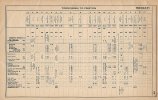What general "rules" would dictate which one a train would be shown in?
I can understand that if a train is only running once, say for a special / holiday excursion it would likely be in an STN.
I'm told that in 1959 the C223 Blackburn - Scarborough / Filey holiday camp (twice) plus one from Padiham (once) and Westhoughton (once) were in the WTT.
I can find no such train in my 1962 WTT? I know it was still running in 1964.
What it does show is the 1M09 7.04am Rotherham to Blackpool North (SO)... the thing is with this one, it only runs twice. 28 July & 4 August.
Why can't I find that Blackburn - Scarborough train? and why is the 1M09 Rotherham one included in the summer 1962 WTT and not an STN?
Thanks,
Andy.
I can understand that if a train is only running once, say for a special / holiday excursion it would likely be in an STN.
I'm told that in 1959 the C223 Blackburn - Scarborough / Filey holiday camp (twice) plus one from Padiham (once) and Westhoughton (once) were in the WTT.
I can find no such train in my 1962 WTT? I know it was still running in 1964.
What it does show is the 1M09 7.04am Rotherham to Blackpool North (SO)... the thing is with this one, it only runs twice. 28 July & 4 August.
Why can't I find that Blackburn - Scarborough train? and why is the 1M09 Rotherham one included in the summer 1962 WTT and not an STN?
Thanks,
Andy.


 ).
).